Services on Demand
Journal
Article
Indicators
-
 Cited by SciELO
Cited by SciELO -
 Access statistics
Access statistics
Related links
-
 Cited by Google
Cited by Google -
 Similars in
SciELO
Similars in
SciELO -
 Similars in Google
Similars in Google
Share
Caldasia
Print version ISSN 0366-5232On-line version ISSN 2357-3759
Caldasia vol.32 no.1 Bogotá Jan./June 2010
Camarones de agua dulce de los afluentes colombianos de los ríos Amazonas y Orinoco (Palaemonidae, Euryrhynchidae, Sergestidae)
DIEGO M. VALENCIA
Universidad de Bogotá Jorge Tadeo Lozano. diego.valencia@utadeo.edu.co
MARTHA R. CAMPOS
Instituto de Ciencias Naturales, Universidad Nacional de Colombia, Apartado 7495, Bogotá, D. C., Colombia. mhrochad@unal.edu.co
ABSTRACT
A review of freshwater shrimps belonging to the genera Palaemonetes, Pseudopalaemon, Euryrhynchus and Acetes of the Colombian tributaries of the Amazon and Orinoco Rivers is presented. The species found in this work are recorded for the first time for Colombia: Palaemonetes ivonicus Holthuis, 1950, Palaemonetes mercedae Pereira, 1986, Pseudopalaemon amazonensis Ramos-Porto, 1979, Pseudopalemon chryseus Kensley & Walker, 1982, Euryrhynchus amazoniensis Tiefenbacher, 1978 and Acetes paraguayensis Hansen, 1919. Diagnoses, illustrations, distributional data and a key to the families, genera and species are presented.
Key words. Freshwater shrimps, Palaemonidae, Euryrhynchydae, Sergestidae, Colombian tributaries of Amazon and Orinoco Rivers.
RESUMEN
Se presenta una revisión de los camarones de agua dulce de los géneros Palaemonetes, Pseudopalaemon, Euryrhynchus y Acetes de los afluentes de los ríos Amozonas y Orinoco de Colombia. Las especies registradas en este trabajo constituyen los primeros registros para Colombia: Palaemonetes ivonicus Holthuis, 1950, Palaemonetes mercedae Pereira, 1986, Pseudopalaemon amazonensis Ramos-Porto, 1979, Pseudopalemon chryseus Kensley & Walker, 1982, Euryrhynchus amazoniensis Tiefenbacher, 1978 y Acetes paraguayensis Hansen, 1919. Se presentan las diagnosis, las ilustraciones, los datos sobre distribución y una clave para las familias, géneros y especies.
Palabras clave. Camarones de agua dulce, Palaemonidae, Euryrhynchydae, Sergestidae, afluentes de los ríos Amazonas y Orinoco de Colombia.
Recibido: 24/10/2009
Aceptado: 04/05/2010
INTRODUCTION
The freshwater shrimps are one of the most important groups of invertebrates in decaying organic matter (Wantzen & Wagner, 2006). The shrimps also constitute a fundamental element in the aquatic ecosystem fauna, where they function as macroconsumers.
Taxonomic and distributional studies of the freshwater shrimps that are in the Amazonian and Orinoquian regions can be found in Holthuis (1952); Rodríguez (1982); Kensley & Walker (1982); Pereira (1986, 1991); López & Pereira, (1996); and García-Dávila & Magalhães (2004). However, in these river basins in Colombia, this group is very little known and the few studies available are restricted to the species of Macrobrachium Bate, 1868 (Holthuis, 1952; Medina & Sobrino, 1975; Campos, 1997; Valencia & Campos, 2007). According to Valencia & Campos (2007), the genus Macrobrachium includes approximately 200 species, 20 of them are registered for Colombia.
The present study aims to contribute to the knowledge of the freshwater shrimps of the Colombian tributaries of the Amazon and Orinoco Rivers, belonging to the genera Palaemonetes Heller, 1869, Pseudopalaemon Sollaud, 1911, Euryrhynchus Miers, 1877 and Acetes H. Milne Edwards, 1830. The study was based in material deposited in the Crustacean Collection of the Instituto de Ciencias Naturales, Universidad Nacional de Colombia, Bogotá (ICN-MHN-CR). The abbreviations TL and CL stand for total length, and carapace length, respectively. The total length is taken from the anterior end of the rostrum to the posterior end of the telson; the carapace length is taken from the posterior margin of the orbit to the posterior margin of the carapace.
Key to families, genera and species of the Colombian tributaries of the Amazon and Orinoco Rivers
1. Pleura of second abdominal somite not overlaping the first one. Fourth or fifth pair of pereopods reduced or absent (Family Sergestidae). Rostrum shorter than proximal margin of eyestalk (Fig. 11A)..........................................Acetes paraguayensis
1'. Pleura of second abdominal somite overlaping the first one. The five pairs of pereopods well developed. Rostrum longer than proximal margin of eyestalk.........2
2. Upper antenular flagelum with rami enterely free. (Family Euryrhynchidae). Rostrum without teeth on upper and lower margin (Fig. 1A)..........Euryrhynchus amazoniensis
2'. Upper antenular flagelum with rami joined at base. (Family Palaemonidae). Rostrum with teeth on upper and lower margin (Fig. 3A,B)......................3
3. Hepatic spine absent; branchiostegal spine present (Genus Palaemonetes) (Fig. 3A,B)........................................................4
3'. Hepatic spine present; branchiostegal spine absent (Genus Pseudopalaemon) (Fig. 7A)..........................................5
4. Telson terminal margin ending in sharp midpoint, overreached by inner pair of spinules; posterior margin of telson with two setae (Fig. 3D)......................................................Palaemonetes ivonicus
4'. Telson terminal margin rounded, not overreached by inner pair of spinules; posterior margin of telson with numerous setae (Fig. 5B)..........Palaemonetes mercedae
5. Rostrum sinuous, distal portion directed upwards (Fig. 7A)...........................................Pseudopalaemon amazonensis
5'. Rostrum straight, without distal portion directed upwards (Fig. 9A)...............................Pseudopalaemon chryseus
Suborder Pleocyemata Burkenroad, 1963
Infraorder Caridea Dana 1852
Super family Palaemonoidea Rafinesque, 1815
Family Euryrhynchidae Holthuis, 1950
Genus Euryrhynchus Miers, 1877
Euryrhynchus amazoniensis Tiefenbacher, 1978
Figs. 1, 2
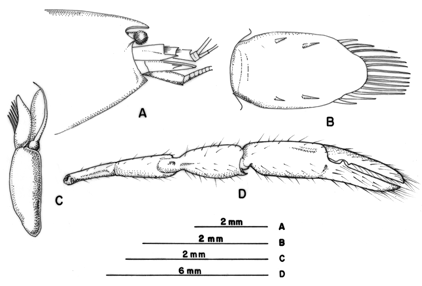
Material examined. Amazonas: Leticia, Corregimiento La Pedrera, Izáciga stream, 120 m asl, 9 Nov 1994, leg. M. R. Campos, 2 males, 5 females, 1 ovigerous, ICN-MHN-CR 2548; Leticia, Corregimiento La Pedrera, Mirití River, El Puerto, 180 m asl, 16 Nov 1994, leg. M. R. Campos, 1 male, ICN-MHN-CR 2549. Guainía: Inírida, Caimán creek, 70 m asl, 19 Mar 1998, leg. M. R. Campos, 1 male, 1 female, ICN-MHN-CR 2550; Inírida, Lombriz Lake, 75 m asl, 20 Mar 1998, leg. M. R. Campos, 1 male, ICN-MHN-CR 2551. Vichada: Cumaribo, Mayoragua creek, 50 m asl, 15 May 1985, leg. G. Galvis, 1 male, 1 female, ICN-MHN-CR 1735.
Diagnosis. Rostrum short, straight, sharp, unarmed on upper and lower margins (Fig. 1A). Second pair of pereopods different in size and pubescent; the larger second pereopod overreaching scaphocerite with entire carpus; merus 0.7 to 1.0 x carpus length, 0.7 to 1.0 x palm length, and 0.4 x chela length; carpus 0.4 to 0.6 x chela length, with a spine at inner distal border; fingers 1.0 to 1.2 x palm length, 1 to 2 teeth on proximal portion in cutting edge of each fingers (Fig. 1D). Second male pleopod with endopod shorter than exopod, with spines on mesial and postero-lateral borders (Fig. 1C). Telson with posterior margin nearly rounded, flanked by two pairs of spinules and numerous setae between them, inner pair overreaching both midpoint and external pair (Fig. 1B).
Size. The largest male TL 18.2 mm, CL 6.2 mm; the largest female TL 16.5, CL 5.5 mm; 1 ovigerous female was examined: TL 15.1 mm, CL 5.0 mm.
Previous records. Brazil (Kensley & Walker,1982; Melo, 2003); Peru (García-Dávila & Magalhães, 2004) and Venezuela (Pereira, 1991; López & Pereira, 1996, 1998).
Distribution for Colombia. The new records including herein, extend its range of distribution to the Caquetá, Inírida and Vichada River basins (Fig. 2).
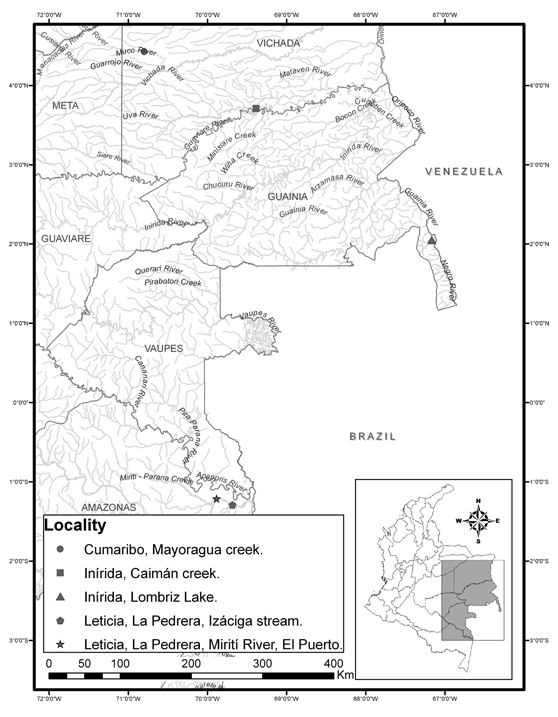
Family Palaemonidae Rafinesque, 1815
Genus Palaemonetes Heller, 1869
Palaemonetes ivonicus Holthuis, 1950
Fig. 3, Fig. 4
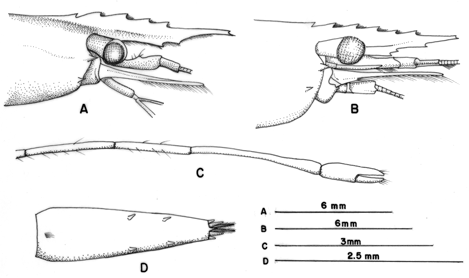
Figure 3. Palaemonetes ivonicus Holthuis, 1950, male, ICN-MHN-CR 2534: A, C, D; male, ICN-MHN-CR 1736: B. A, anterior part of body, lateral view; B, anterior part of body, lateral view; C, second pereopod, lateral view; D, telson, dorsal view.
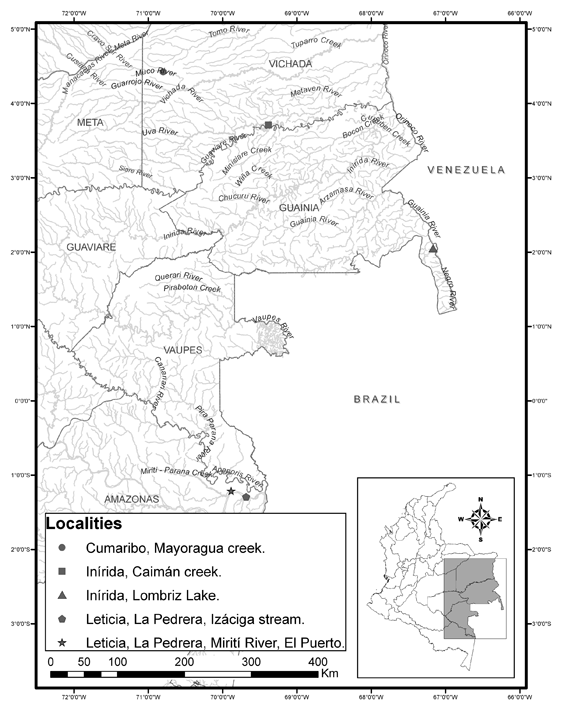
Material examined. Amazonas: Leticia, Tarapacá, 80 m asl, 20 Jan 1999, leg. G. Galvis, 3 females, 2 ovigerous, ICN-MHN-CR 2540. Arauca: Caño Limón, Agua Verde Lake, 125 m asl, 15 Aug 1991, leg. G. Galvis, 1 male, 3 ovigerous females, ICN-MHN-CR 2545. Casanare: Maní, Casimena creek, affluent of Cusiana River, 150 m asl, 25 Feb 1974, leg. P. Cala, 1 female, ICN-MHN-CR 2535; Maní, Casimena creek, affluent of Cusiana River, 175 m asl, 26 Feb 1971, leg. P. Cala, 1 female, ICN-MHN-CR 2538; Orocué, La Argentina Farm, San Miguel creek, 130 m asl, 29 May 2000, leg. A. Suárez, 1 female, ICN-MHN-CR 2534. Guainía: Inírida, Lombriz Lake, 75 m asl, 20 Mar 1998, leg. M. R. Campos, 1 male, 1 female, ICN-MHN-CR 1686; Inírida, Caimán creek, 70 m asl, 19 Mar 1998, leg. M. R. Campos, 2 females, ICN-MHN-CR 2537; Inírida, Agujón creek, 70 m asl, 23 Mar 1998, leg. M. R. Campos, 1 female, ICN-MHN-CR 2539. Meta: Puerto Gaitán, Vereda Santa Fé, Palmita creek, affluent of Muco River, 200 m asl, 17 Jul 1974, leg. P. Cala, 1 male, ICN-MHN-CR 2536. Vichada: Cumaribo, Carimagua Lake, 12 May 1985, leg. G. Galvis, 3 males, 21 females, ICN-MHN-CR 0668; Cumaribo, Mayoragua creek, 50 m asl, 15 May 1985, leg. G. Galvis, 8 males, 47 females, 1 ovigerous, ICN-MHN-CR 1736.
Diagnosis. Rostrum straight, as long as or slightly longer than scaphocerite; upper margin with 6 to 9 teeth, including 1 to 3 completely post orbital, lower margin 1 to 4 teeth (Fig. 3A,B). Second pair of pereopods elongated and slender, similar in shape and size, overreaching scaphocerite with 1/3 of chela to 2/3 of carpus, merus 0.5 to 0.7 x carpus length, 1.6 to 2.2 x palm length, and 0.9 to 1.2 chela length; carpus 1.6 to 2.2 x chela length; fingers 0.6 to 1.0 x palm length; fingers not gaping when closed (Fig. 3C). Telson with posterior margin ending in sharp midpoint, flanked by two pairs of spinules, inner pair overreaching midpoint and external pair, 2 feathered setae between inner pair (Fig. 3D).
Size. The largest male TL 25.2 mm, CL 4.9 mm; the largest female TL 34.2, CL 7.0 mm; 6 ovigerous females were examined: TL 26.1 to 32.7 mm, CL 5.4 to 6.5 mm.
Previous records. Brazil (Holthuis, 1966; Melo, 2003); Bolivia (Holthuis, 1952; Melo, 2003, Magalhães, 2002); Paraguay (Magalhães, 2001); Peru (García-Dávila & Magalhães, 2004); Venezuela (López & Pereira, 1996, 1998).
Distribution for Colombia. The new records including herein extend its range of distribution to the Amazon, Arauca, Cusiana, Inírida, Meta and Vichada River basins (Fig. 4).
Palaemonetes mercedae Pereira, 1986
Fig. 5, Fig. 6
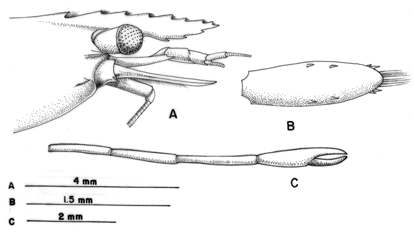
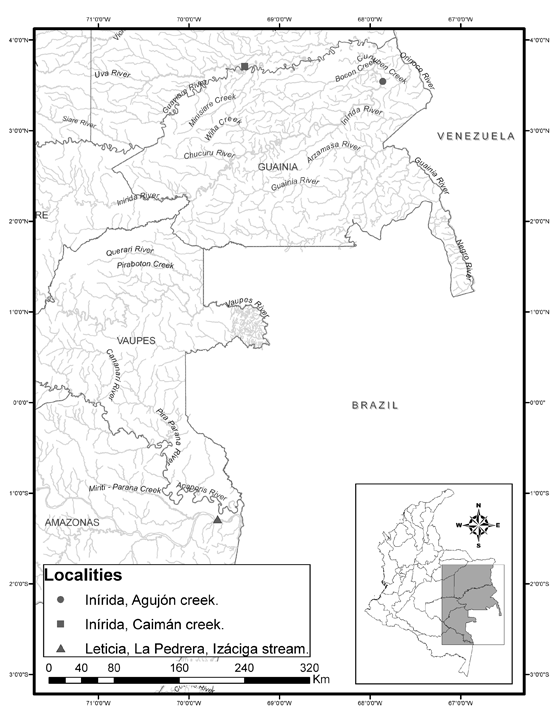
Material examined. Amazonas: Leticia, Corregimiento La Pedrera, Izáciga stream, 120 m asl, 9 Nov 1994, leg. M. R. Campos, 1 female, ICN-MHN-CR 2544. Guainía: Inírida, Agujón creek, 70 m asl, 25 Mar 1998, leg. M. R. Campos, 1 female, ICN-MHN-CR 2541; Inírida, Caimán creek, 70 m asl, 19 Mar 1998, leg. M. R. Campos, 1 female, ICN-MHN-CR 2542; Inírida, Agujón creek, 70 m asl, 23 Mar 1998, leg. M. R. Campos, 3 males, 1 female, ICN-MHN-CR 2543.
Diagnosis. Rostrum straight, as long as scaphocerite; upper margin with 7 to 9 teeth, including 1 to 2 completely post orbital, lower margin 2 to 3 teeth (Fig. 5A). Second pair of pereopods slender, similar in shape and size, overreaching scaphocerite with 1/3 of chela to 2/3 of carpus; merus 0.7 to 0.8 x carpus length, 1.2 to 1.4 x palm length, and 0.7 to 0.9 chela length; carpus 0.9 to 1.1 x chela length; fingers 0.6 to 0.7 x palm length (5C). Telson with posterior margin rounded, flanked by two pairs of spinules, inner pair not overreached midpoint; posterior margin of telson with numerous setae (Fig. 5B).
Size. The largest male TL 13.0 mm, CL 2.9 mm; 1 ovigerous female was examined: TL 16.2 mm, CL 4.1 mm.
Previous records. Brazil (Magalhães, 1988; Melo, 2003) and Venezuela (Pereira, 1986).
Distribution for Colombia. The new records including herein extend its range of distribution to the Caquetá and Inírida River basins (Fig. 6).
Genus Pseudopalaemon Sollaud, 1911
Pseudopalaemon amazonensis Ramos-Porto, 1979
Fig. 7, Fig. 8
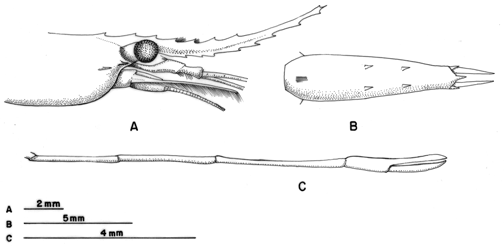
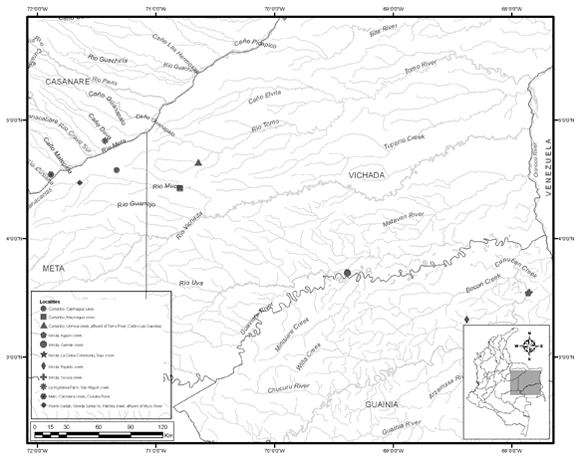
Material examined. Casanare: Maní, Casimena creek, affluent of Cusiana River, 150 m asl, 25 Feb 1974, leg. P. Cala, 2 males, 3 females, ICN-MHN-CR 1812; Orocué, La Argentina Farm, San Miguel creek, 29 May 2000, leg. A. Suárez, 1 female, ICN-MHN-CR 1878. Guainía: Inírida, La Ceiba Community, Seje creek, 80 m asl, 18 Mar 1998, leg. M. R. Campos, 8 males, 6 females, ICN-MHN-CR 1681; Inírida, Caimán creek, 70 m asl, 19 Mar 1998, leg. M. R. Campos, 1 male, 1 female, ICN-MHN-CR 1682; Inírida, Pajarito creek, 70 m asl, 21 Mar 1998, leg. M. R. Campos, 1 female, ICN-MHN-CR 1689; Inírida, Agujón creek, 70 m asl, 23,25 Mar 1998, leg. M. R. Campos, 7 males, 14 females, ICN-MHN-CR 1692, 1696; Inírida, Yucuta creek, 70 m asl, 24 Mar 1998, leg. M. R. Campos, 2 males, 11 females, ICN-MHN-CR 1694. Meta: Puerto Gaitán, Vereda Santa Fé, Palmita creek, affluent of Muco River, 200 m asl, 17 Jul 1974, leg. P. Cala, 9 females, ICN-MHN-CR 1799. Vichada: Cumaribo, Urimica creek, affluent of Tomo River, Centro Las Gaviotas, 160 m asl, 16, 17 Jul 1974, leg. P. Cala, 31 males, 20 females, 1 juvenile, ICN-MHN-CR 1798, 1803; Cumaribo, Carimagua Lake, 12 May 1985, leg. G. Galvis, 4 males, 1 female, ICN-MHN-CR 2546; Cumaribo, Mayoragua creek, 50 m asl, 15 May 1985, leg. G. Galvis, 3 males, 4 females, ICN-MHN-CR 2547.
Diagnosis. Rostrum sinuous, overreaching scaphocerite, distal portion directed upwards; upper margin with 6 to 11 teeth, including 1 to 2 completely postorbital, lower margin 4 to 9 teeth (Fig. 7A). Second pair of pereopods elongated and slender, similar in shape and size, overreaching scaphocerite completely with chela to 3/4 of carpus; merus 0.6 to 0.8 x carpus length, 1.5 to 2.4 x palm length, and 0.7 to 1.0 X chela length; carpus 1.0 to 1.5 x chela length; fingers 0.8 to 2.2 x palm length; fingers not gaping when closed, cutting edges smooth (Fig. 7C). Telson with posterior margin ending in sharp midpoint, flanked by two pairs of spinules, internal pair overreaching midpoint and external pair (Fig. 7B).
Size. The largest male TL 38.2 mm, CL 6.2 mm; largest female TL 41.4 mm, CL 7.5 mm; 18 ovigerous females were examined: TL 31.3 to 37.7 mm, CL 6.1 to 7.7 mm.
Previous records. Brazil (Kensley & Walker, 1982; Melo, 2003) and Venezuela (Pereira, 1991).
Distribution for Colombia. The new records including herein extend its range of distribution to the Cusiana, Inírida, Meta, Tomo and Vichada River basins (Fig. 8).
Pseudopalaemon chryseus Kensley & Walker, 1982
Fig. 9, Fig. 10
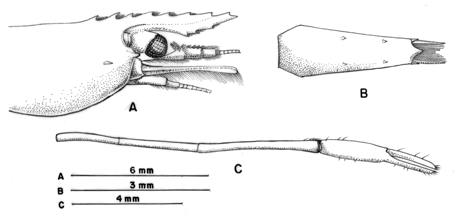
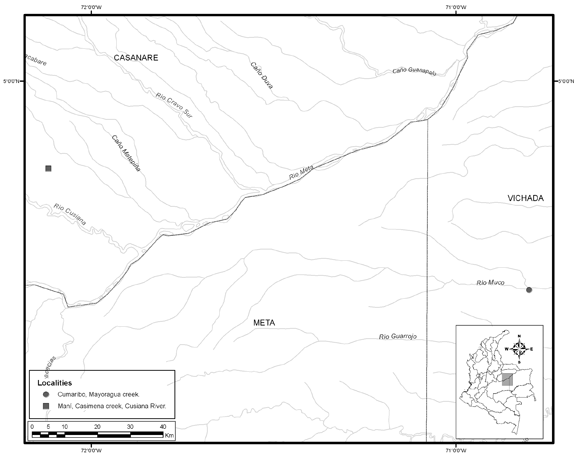
Material examined. Casanare: Maní, Casimena creek, affluent of Cusiana River, 175 m, 26 Feb, 1971, leg. P. Cala, 12 hembras, ICN-MHN-CR 0029. Vichada: Cumaribo, Mayoragua creek, 50 m, 15 May 1985, leg. G. Galvis, 2 machos, 13 hembras, ICN-MHN-CR 2554.
Diagnosis. Rostrum straight, as long as or slightly longer than scaphocerite; upper margin with 7 to 11 teeth, including 2 completely postorbital, lower margin 3 to 4 teeth (Fig. 9A). Second pair of pereopods elongated and slender, similar in shape and size, overreaching scaphocerite with 1/4 to 2/3 of carpus; merus 0.6 to 0.7 x carpus length, 1.3 to 1.6 x palm length, and 0.7 to 0.8 x chela length; carpus 1.0 to 1.1 x chela length; fingers 0.7 to 1.0 x palm length; fingers not gaping when closed (Fig. 9C). Telson with margin ending in sharp midpoint, flanked by two pairs of spinules, internal pair overreaching midpoint and external pair (Fig. 9B).
Size. The largest male TL 19.1 mm, CL 4.3 mm; largest female TL 22.3 mm, CL 5.7 mm.
Previous records. Brazil (Kensley & Walker, 1982; Melo, 2003).
Distribution for Colombia. The new records including herein, extend its range of distribution to the Cusiana and Vichada River basins (Fig. 10).
Suborder Dendrobranchiata Latreille, 1802.
Superfamily Sergestoidea Dana, 1852.
Family Sergestidae Dana, 1852
Genus Acetes H. Milne Edwards, 1830
Acetes paraguayensis Hansen, 1919
Fig. 11, Fig. 12
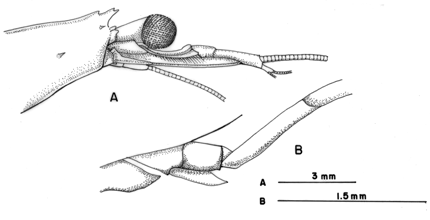
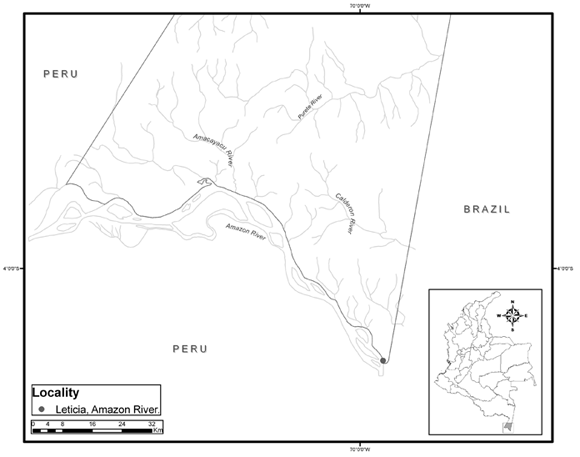
Material examined. Amazonas: Leticia, Amazon River, 80 m asl, 22 Jan 2008, leg. I. Mojica, 1 male, ICN-MHN-CR 2559.
Diagnosis. Rostrum shorter than proximal margin of eyestalk, with prominent dorsal tooth, and small subterminal one (Fig. 11A). Coxa of third pair of pereopods with acute spine (Fig. 11B). Telson with posterior margin rounded with numerous setae.
Size. Male TL 19.1 mm, CL 5.0 mm.
Previous records. Venezuela (Rodríguez, 1982; Melo, 2003); Bolivia (Magalhães, 2002); Peru (García-Dávila & Magalhães, 2004; Melo, 2003); Suriname (Melo, 2003), Paraguay, Argentina (Hansen, 1919; Melo, 2003), and Brazil (Melo, 2003).
Distribution for Colombia. The new records including herein, extend its range of distribution to the Amazon River basin (Fig. 12).
Remarks. The female specimens reported by García-Dávila & Magalhães, (2004) presented the coxa of the third pair of pereopods rounded and devoided of the spine.
ACKNOWLEDGMENTS
The autors are very grateful to Dr. Celio Magalhães for loaned material of the INPA collection and the constructive comments on the manuscript. We would also like to thank Héctor Suárez for providing important comments on the manuscript. The illustrations were prepared by Gilberto Mendoza. The maps were elaborated by Rubén Darío Albarracín.
LITERATURE CITED
1. BURKENROAD, M.D. 1963. The evolution of the Eucarida (Crustacea, Eumalacostraca) in relation to the fossil record. Tulane Studies in Geology 2: 3 - 16. [ Links ]
2. CAMPOS, M.R. 1997. Crustáceos, Decápodos. In: Instituto Geográfico Agustín Codazzi Ed. Zonificación Ambiental para el Plan Modelo Colombo Brasilero, Eje Apaporis-Tabatinga: PAT, Edit. Linotipia Bolivar. p. 231 - 235. [ Links ]
3. DANA, J.D. 1852. Crustacea. United States Exploring Expedition during the year 1838, 1839, 1840, 1841, 1842 under the command of Charles Wilkes, United States Naval Academy 13: 1 - 1620. [ Links ]
4. GARCÍA-DÁVILA, C.R. & C. MAGALHÃES. 2004. Revisão taxonomica dos camarões de água doce (Crustacea: Decapoda: Palaemonidae, Sergestidae) da Amazonia Peruana. Acta Amazonica 33: 663-686. [ Links ]
5. HANSEN, H.J. 1919. The Sergestidae of the Siboga Expedition. Siboga Expedition 38: 1 - 65, pls. 1-15. [ Links ]
6. HELLER, C. 1869. Zur näheren Kentniss der in den süssen Gewassern des sudlichen Europa vorkommendem Meerescrustaceen. Zeitschrift der Wissenschaffliche Zoologie 19: 156 -162. [ Links ]
7. HOLTHUIS, L.B. 1950. Preliminary descriptions of twelve new species of Palemonid prawns from American waters (Crustacea: Decapoda). Proceedings Koninklijke Nederlandische Akademie van Wetenschapen 53: 93 - 99. [ Links ]
8. HOLTHUIS, L.B. 1952. A general revision of the Palaemonidae (Crustacea: Decapoda: Natantia) of the Americas. II. the subfamily Palaemoninae. Allan Hancock Foundation Publications, Occasional Papers 12: 1 - 396. [ Links ]
9. HOLTHUIS, L.B. 1966. A collection of freshwater prawns (Crustacea: Decapoda: Palaemonidae) from Amazonia, Brazil, collected by Dr. G. Marlier. Bulletin Institut Royal des Sciences naturelles des Belgique 42 (10): 1-11. [ Links ]
10. KENSLEY, B. & I. WALKER. 1982. Palaemonid shrimps from the Amazon Basin, Brazil (Crustacea: Decapoda: Palaemonidae). Smithsonian Contribution to Zoology 362: 1 - 28. [ Links ]
11. LATREILLE, P.A. 1902. Histoire naturelle généralle et particulière des Crustacés et des Insectes 3: 1 - 467. [ Links ]
12. LÓPEZ, B. & G. PEREIRA. 1996. Inventario de los crustáceos decápodos de las zona alta y media del Delta de Río Orinoco, Venezuela. Acta Biológica Venezuelica 16: 45 - 64. [ Links ]
13. LÓPEZ, B. & G. PEREIRA. 1998. Actualización del inventario de crustáceos decápodos del Delta de Río Orinoco. In López, J. L., I. I. Saavedra & M. Dubois (eds.), El río Orinoco Aprovechamiento sustentable. Memorias de ls primeras jornadas venezolanas de investigación sobre el río Orinoco, Caracas. p. 76 - 85. [ Links ]
14. MAGALHÃES, C. 1988. The larval development of Palaemonid shrimps from the Amazon region reared in the laboratory. II. Extremely abbreviated larval development in Euryrhynchus Miers, 1877 (Decapoda, Euryrhynchinae). Crustaceana 55: 39 - 52. [ Links ]
15. MAGALHÃES, C. 2001. Diversity, distribution, and habitats of the macro-invertebrate fauna of the Río Paraguay and Río Apa, Paraguay, with emphasis on Decapod Crustaceans. In Chernoff, B.; P.W. Willink & J. R. Montambault (eds.), A Biological Assessment of the Acuatic Ecosystems of the Río Paraguay Basin, Alto Paraguay, Paraguay. Conservation International. RAP Bulletin of Biological Assessment, Washington 19: 68 - 72 . [ Links ]
16. MAGALHÃES, C. 2002. A rapid assessment of the decapod fauna in the Río Tahuamanu and Río Manuripi Basins, with new records of shrimps and crabs for Bolivia (Crustacea, Decapoda, Palaemonidae, Sergestidae, Trichodactylidae). Revista Brasileira de Zoologia 19: 1091 - 1103. [ Links ]
17. MEDINA, R. & A. SOBRINO A. 1975. Contribución a la ecología, cultivo de larvas en laboratorio y descripción de estadios larvales del camarón de agua dulce Macrobrachium amazonicum (Heller) Decapoda, Palaemonidae. Tesis de grado, Departamento de Biología, Universidad Nacional de Colombia, Bogotá 1 - 94. [ Links ]
18. MELO, G.A.S. 2003. Famílias Atydae, Palaemonidae e Sergestidae. In: Melo, G. A. S. (Ed.), Manual de identificacão dos Crustacea Decapoda de Agua Doce do Brasil. Edições Loyola, São Paulo. p. 289 - 415. [ Links ]
19. MIERS, E.J. 1877. On a collection of Crustacea Decapoda an Isopoda, chiefly from South America, with descriptions of new genera and species. Proceedings of the Zoological Society of London 1877: 653 - 679. [ Links ]
20. MILNE EDWARDS, H. 1830. Description des genres Glaucothoé, Sycionie, Sergeste et Acete de l´ ordre des Crustacés Décapodes. Annales des Sciences Naturelles 19: 333 - 351. [ Links ]
21. PEREIRA, G. 1986. Freshwater shrimps from Venezuela I: seven new species of Palaemoninae (Crustacea: Decapoda: Palaemonidae). Proceedings of the Biological Society of Washington 99: 198 - 213. [ Links ]
22. PEREIRA, G. 1991. Camarones de agua dulce de Venezuela II: nuevas adiciones en las familias Atydae y Palaemonidae (Crustacea: Decapoda: Caridea). Acta Biológica Venezuelica 13: 75 - 88. [ Links ]
23. RAFINESQUE, L.S. 1815. Analyse de la Nature ou tableau de l' universe et des corps organisés 1 - 224. [ Links ]
24. RAMOS-PORTO, M. 1979. Pseudopalaemon amazonenesis, espécie nova de camarão de bacia amazônica (Crustacea, Decapoda, Palaemonidae). Sociedade Brasileira Para o Progresso da Ciencia, 31 Reuniao Anual, Resumos, Suplemento de Ciencia e Cultura 31: 693. [ Links ]
25. RODRÍGUEZ, G. 1982. Freshwater shrimps (Crustacea, Decapoda, Natantia) of the Orinoco basin and the Venezuelan Guayana. Journal of Crustacean Biology 2: 378 - 391. [ Links ]
26. SOLLAUD, E. 1911. Pseudopalaemon bouvieri, nouveau genre, nouvelle espece, de la famille des Palaemonidae. Bulletin du Muséum d'Histoire Naturelle 17: 12 - 16. [ Links ]
27. TEIFENBACHER, L. 1978. Zur Systematik und Verbreitung der Euryrhynchinae (Decapoda, Natantia, Palaemonidae). Crustaceana 35: 177 - 189. [ Links ]
28. VALENCIA, D. M. & M. R. CAMPOS. 2007. Freshwater prawns of the genus Macrobrachium Bate, 1868 (Crustacea: Decapoda: Palaemonidae) of Colombia. Zootaxa 1456: 1 - 44. [ Links ]
29. WANTZEN, K. M. & R. WAGNER. 2006. Detritus processing by invertebrate shredders a netropical-temperate comparison. Journal of the North American Benthological Society 25: 216 - 232. [ Links ]














